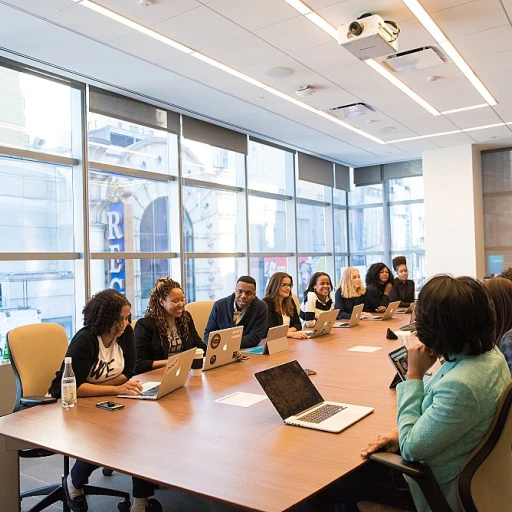Understanding the Employee Journey
Mapping the Employee Experience
Every employee's journey within a company is unique, but common threads exist in understanding the broader narrative. Employee experience is shaped through various stages, beginning with recruitment and stretching out to retirement or resignation. Recognizing these stages helps organizations identify "moments that matter" and ensures that employees feel valued and engaged at every point along the way. So, let's unpack what makes an employee journey truly meaningful.
Employees move through different stages during their time with a company, and this path isn't just about work tasks. It's about how people feel and are supported throughout their tenure. From onboarding to development opportunities, each touchpoint in the journey adds layers to the overall experience. By creating a detailed journey map, companies can better understand where they might excel or need improvement. These journey maps help in spotting pain points, enabling companies to smooth out any bumps that might occur.
Journey mapping is a valuable tool. It allows organizations to see potential gaps and areas for better engagement, as well as measure the impact of the employee experience. By using data and feedback, companies can craft more personalized employee experiences. An organization's workforce is its lifeblood, and understanding their journey is crucial for fostering a positive company culture and enhancing employee engagement. If you're curious about strategies to enhance the employee experience, you might want to check out some expert advice on
strategies to enhance the employee experience.
Building a positive work environment means recognizing where each employee is on their journey and providing the right support at the right time. As organizations work to improve employee performance management, understanding the entire employee experience helps boost morale, reduce turnover, and enhance overall satisfaction. After all, when organizations invest in the employee journey, they invest in their future, making it brighter and more promising for everyone involved.
The Role of Personalization in Employee Experience
Making Work Personal
When it comes to the employee experience, the magic happens when work feels personal. It's about creating an environment where employees feel valued and understood. Personalization is the secret sauce that makes this possible. It's not just about throwing in a few perks or benefits; it's about understanding what makes each employee tick and aligning their work life with their personal and professional goals.
Mapping the Way
Personalization starts with a good map. Companies need to understand the employee journey and identify key moments that matter. This involves mapping out the entire employee life cycle, from recruitment to retirement, and pinpointing where personalization can make a difference. Think of it as a roadmap to a more engaged workforce.
Communication is Key
Personalization thrives on communication. It's about having open channels where employees can share their thoughts and feedback. This isn't just a one-time survey; it's an ongoing conversation. Companies that succeed in personalization listen to their employees and make adjustments based on what they hear. This creates a culture of trust and engagement.
Data Drives Personalization
To personalize effectively, companies need to use data wisely. This doesn't mean collecting data for the sake of it, but using it to understand employee preferences and pain points. It's about creating a personalized employee experience that resonates with the workforce. Data helps in making informed decisions that improve employee engagement and satisfaction.
Performance Management with a Personal Touch
Personalized performance management is another key aspect. It's about recognizing individual contributions and providing tailored feedback. Employees appreciate when their unique skills and efforts are acknowledged. This not only boosts morale but also enhances productivity.
In the end, personalization is about making employees feel like they're not just a number. It's about creating an environment where they can thrive and contribute to the company's success. For more insights on how personalization can enhance employee experience, check out this article on key interaction points.
Personalizing Employee Interaction: Tools and Technologies
Creating an environment where employees feel valued involves a personalized approach, made possible by an impressive array of tools and technologies. Sure, it's essential to treat employees as individuals but achieving this, especially in large organizations, requires a bit of tech magic.
One of the most effective methods is through employee journey mapping systems. These tools piece together each employee's journey with the company, identifying touchpoints that matter most. Imagine knowing exactly when and how to communicate with employees to boost engagement and satisfaction. Journey maps are powerful in visualizing pain points and crafting better experiences, all based on real data.
Plus, ever wondered how your feedback system is doing in shaping the work environment? Tools that leverage employee feedback loops are game-changers, allowing insights to flow both ways between staff and management. These loops not only shape a positive work experience but make employees feel heard and valued.
Learn more about feedback loops here.
Performance management platforms also play a significant role. They aren't just about tracking; they personalize the conversation around performance, setting employees up for success by pinpointing individual strengths and areas for improvement. Employees become more engaged when they see a clear path for growth.
Finally, personalized communication tools streamline interactions across the company. They provide employees with the information and engagement they need. A mix of AI-driven insights and human touch offers the perfect balance for keeping the workforce motivated and informed.
Personalization tech is about making moments matter, ensuring that each step of an employee's journey is engaging and fulfilling. With the right tools, a company can not only improve employee experiences but reshape their overall organizational culture. That's where the benefits really start to shine—when employees see and feel a personalized approach to their work life.
Overcoming Challenges in Personalization
Breaking Down Barriers for Personalized Experiences
To bring personalized experiences to life in a company, it's like having a toolbox that might occasionally run out of a specific tool. Some days, you just can't find the right wrench to tweak an employee's experience, and that's completely normal. Here are some common bumps in the road and how organizations smooth them out to perfect the employee journey.
Employee personalization sounds fantastic, and it is, as long as companies can get all those pieces working together. One of the biggest hurdles is communication. Picture this: the HR team and department managers aren't on the same page about what personalization means. Employees might hear different stories depending on who they ask. That's why open lines of communication between all parts of an organization are crucial. Having everyone understand and commit to the process provides a consistent experience for employees.
Then, there's the juggle between data privacy and helping employees. Personalization thrives on data that tells a story: when and where people work best, their motivations, and even feedback from performance management systems. Companies must balance the benefits of using data with employees’ comfort levels about what's being collected. Creating a transparent culture where employees feel empowered and informed makes the conversation about data more productive.
But what if a seemingly perfect approach just doesn't land right? This is where organizations harness employee engagement surveys or feedback platforms. These tools help to pinpoint pain points or parts of the journey map that need adjusting. Think of it as doing regular maintenance on your car. It keeps the employee journey running smoothly.
Finally, managing the variation in employee roles is another challenge. Different roles may require varying degrees of flexibility or different incentives, complicating the process of personalization. Success lies in agile frameworks, allowing for tweaks in the journey map that cater to such unique needs without disrupting the overall flow. Knowing what each role needs and wants can significantly improve employee experiences.
In the end, navigating these challenges means cultivating a resilient company culture that’s adaptable and committed to its workforce. Everyone wins when good vibes become as much a part of the work environment as the office coffee machine, making all those moments that matter more meaningful for the employees and the company alike. It's this focus on personalized employee journeys that paves the path for satisfaction and sustained success in any organization.
Case Studies: Success Stories
Real Stories of Personalization Success
In the world of employee experience, sometimes the best way to understand the benefits of personalization is to see how it has truly made a difference in real-world settings. When companies take the time to map out their employee journeys, customize the work environment, and engage with their workforce, it can drastically improve how employees feel and perform.
One notable example is from a thriving tech company that transformed its employee engagement by focusing on personalized communication and feedback. Recognizing that every person interacts differently, they redesigned their feedback channels to suit individual preferences. From digital surveys to one-on-one coffee chats, feedback became a two-way street where employees felt heard and appreciated. As a result, the organization saw a significant increase in satisfaction and retention rates.
Another inspiring story comes from a financial firm that prioritized understanding the different stages of the employee journey through detailed journey mapping. They gathered data on each stage of the employee life cycle, identifying pain points and opportunities for improvement. By tapping into this insight, they rolled out tailored professional development programs that catered to each employee's aspirations and skill gaps. This led to higher employee performance and a notable boost in overall company culture.
A smaller but equally impactful story hails from a non-profit organization dedicated to enhancing their employee journeys by creating meaningful moments that matter. From personalized welcome packages to celebrating work anniversaries, they highlighted the importance of recognizing individual contributions. This authentic approach nurtured a strong sense of belonging and connection among employees, which significantly increased engagement and productivity.
These case studies illustrate the power of mapping employee experiences with a personalized touch. Personalization emerges as a meaningful strategy that benefits both employees and the company alike, leading to positive outcomes across the board.
Measuring the Impact of Personalization
Checking the Effect of Personalization
When employees start to notice that their experiences are being personalized, the difference can be striking. But how do companies actually measure this impact? It's all about collecting the right data and being ready to act on it. Feedback is your friend here. Regular surveys, one-on-one meetings, and informal feedback sessions can reveal how employees feel about their experiences and what they see as meaningful changes.
Companies need a solid map of the employee journey to accurately capture these "moments that matter." This mapping helps identify any pain points or gaps in the work environment. Addressing these can lead to a more engaged and satisfied workforce. The mapping doesn't just stop at identifying challenges—it tracks improvements, too.
Analytics tools also play a vital role. By analyzing engagement data, companies can pinpoint what's working and where they can improve. Think of it like a performance management system that focuses on the quality of employee experiences, tracking how personalized touches translate into better engagement and productivity.
For organizations contemplating taking this step, the benefits are plenty. Personalized employee experiences can enhance company culture and lead to higher retention rates. When people see that their workplace adapates to their needs, they're more likely to stick around and thrive. The ultimate goal? A happy workforce can propel a company forward in unimaginable ways.
To dive deeper into actual success stories and further practical examples, you might want to check out resources that delve into innovative initiatives that have already transformed employee experiences. They provide insights into how personalization has been a game changer, leading to rewarding outcomes for both employees and employers.
Always remember, when employees feel valued and heard, the whole organization benefits.








